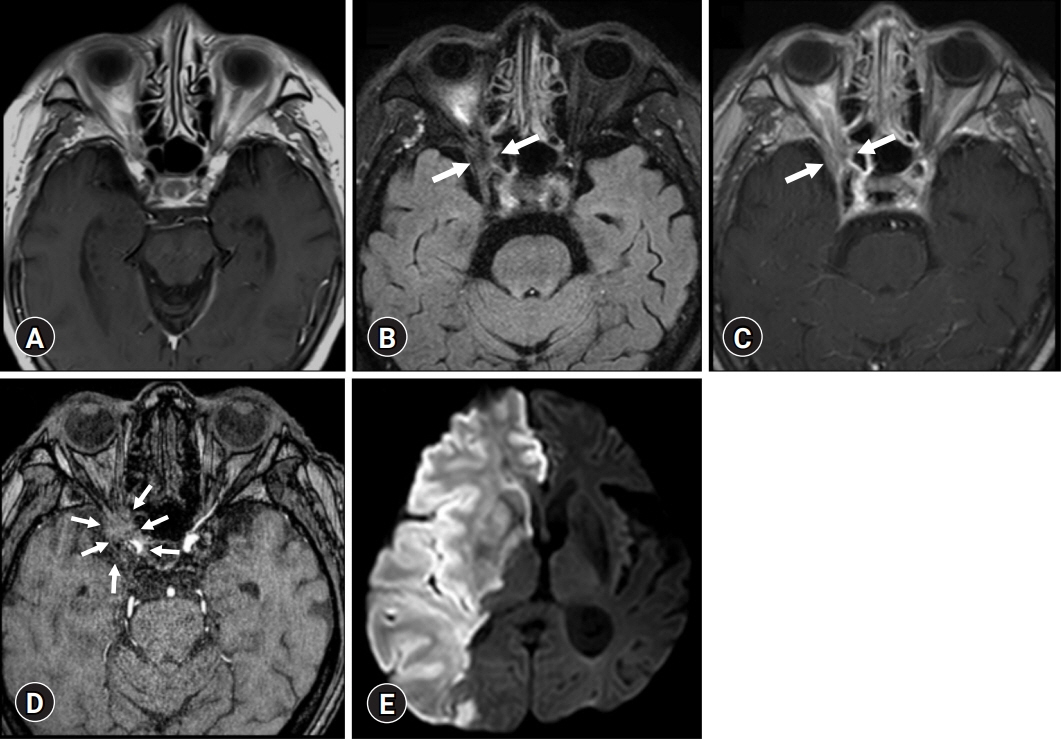J Yeungnam Med Sci.
2023 Apr;40(2):198-201. 10.12701/jyms.2021.01494.
Invasive sphenoid sinus aspergillosis with normal findings on initial diagnostic tests that mimics Tolosa-Hunt syndrome—a diagnostic dilemma: a case report
- Affiliations
-
- 1Department of Neurology, Dongsan Medical Center, Keimyung University School of Medicine, Daegu, Korea
- 2Department of Neurology, Korea University College of Medicine, Seoul, Korea
- KMID: 2541947
- DOI: http://doi.org/10.12701/jyms.2021.01494
Abstract
- Invasive sphenoid sinus aspergillosis can mimic Tolosa-Hunt syndrome (THS), leading to frequent misdiagnoses and potentially fatal consequences. We report a case of invasive sphenoid sinus aspergillosis initially misdiagnosed as THS. A 79-year-old man presented with right periorbital pain, ophthalmoplegia, and loss of vision. Initial evaluations including magnetic resonance imaging (MRI), were normal. He was first diagnosed with THS based on clinical features. The disease progressed despite high-dose intravenous steroid treatment, and an enhancing mass-like lesion was found in the right orbital apex, cavernous sinus, and sphenoid sinus on follow-up MRI. Aspergillosis was eventually confirmed by sphenoid sinus biopsy. The patient developed cerebral infarction and finally died despite being treated with amphotericin B. Given that invasive sphenoid sinus aspergillosis may initially resemble THS, high suspicion and rapid histological examination are important for diagnosis.
Keyword
Figure
Reference
-
References
1. Attout H, Rahmeh F, Ziegler F. Cavernous sinus lymphoma mimicking Tolosa-Hunt syndrome. Rev Med Interne. 2000; 21:795–8.2. Amrutkar C, Burton EV. Tolosa-Hunt syndrome [updated 2021 Aug 11]. In: StatPearls [Internet]. Treasure Island (FL): StatPearls Publishing;2022. [cited 2022 Jan 29]. https://www.ncbi.nlm.nih.gov/books/NBK459225/.3. Walsh TJ, Anaissie EJ, Denning DW, Herbrecht R, Kontoyiannis DP, Marr KA, et al. Treatment of aspergillosis: clinical practice guidelines of the Infectious Diseases Society of America. Clin Infect Dis. 2008; 46:327–60.4. Pushker N, Meel R, Kashyap S, Bajaj MS, Sen S. Invasive aspergillosis of orbit in immunocompetent patients: treatment and outcome. Ophthalmology. 2011; 118:1886–91.5. Siddiqui AA, Shah AA, Bashir SH. Craniocerebral aspergillosis of sinonasal origin in immunocompetent patients: clinical spectrum and outcome in 25 cases. Neurosurgery. 2004; 55:602–13.6. El-Aal AMA, El-Mashad N, Mohamed AN. Revision on the recent diagnostic strategies of fungal infections. Open J Med Microbiol. 2017; 7:29–40.7. Barnes RA. Early diagnosis of fungal infection in immunocompromised patients. J Antimicrob Chemother. 2008; 61(Suppl 1):i3–6.8. Hope WW, Walsh TJ, Denning DW. The invasive and saprophytic syndromes due to Aspergillus spp. Med Mycol. 2005; 43(Suppl 1):S207–38.9. Kumar D, Nepal P, Singh S, Ramanathan S, Khanna M, Sheoran R, et al. CNS aspergilloma mimicking tumors: review of CNS aspergillus infection imaging characteristics in the immunocompetent population. J Neuroradiol. 2018; 45:169–76.10. Kim JP, Park BJ, Lee MS, Lim YJ. Occlusion of the internal carotid artery due to intracranial fungal infection. J Korean Neurosurg Soc. 2011; 49:186–9.



